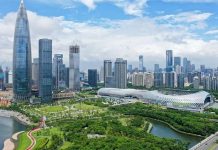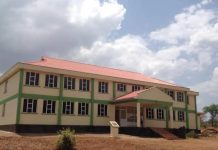AMAJU UBUR YALAMOI AYANI
Africa-Press – South-Sudan. Since the Communist Party of China embarked on reform and opening up to the outside world in 1978, the Chinese modernization has been an iconic phrase whose connotation is largely associated, not only with the economic miracle of the People’s Republic of China, but also with cultural advancement, internal stability, and harmony with the world and nature.
On several occasions, we could hear expressions such as “socialist modernization”, “Chinese-style modernization”, “Chinese modernization drive”, or simply “Chinese path to modernization”.
These phrases have been composed in order to contrast the Chinese transformation with the Western-style modernization.
For nearly half a century, China has been modernizing in its own way. This basically means China has relinquished, both in revolution and in construction, any unrealistic overseas model. According to former Chinese Leader Deng Xiaoping, China must pay greater attention to its long years of experience and focus on an important idea that must integrate the universal truth of Marxism with concrete realities of China, and take its own road of development by building socialism with Chinese characteristics. Although he encouraged China to learn from foreign countries, Xiao Ping warned the cadres of the Communist Party against the mechanical copying and application of far-off experiences and models, asserting that they would take China nowhere.
Instead, China’s affairs should be run according to the specific conditions and by the Chinese people themselves. Independence and self-reliance should always be basic stands of the Chinese nation. China’s journey from a nation once on its knees after years of conflict and isolation to a formidable global economic juggernaut is nothing short of extraordinary. It is a testimony that flies in the face of conventional development wisdom, offering a unique “blueprint” that prioritizes stability, pragmatism, and intensive state-led investment.
For South Sudan, a young country endowed with enormous natural resources but grappling with endemic conflict, developmental hurdles, and systemic corruption, China’s modernization model offers a rich tapestry of lessons, provided that they are applied with local nuance and caution. As South Sudan navigates its complex path forward, the experiences of other developing nations offer valuable lessons. Chinese modernization, characterized by its rapid transformation from an agrarian society to a global economic powerhouse in a few decades, presents a unique case study. While acknowledging the differences in political systems and historical contexts, South Sudan can strategically adapt specific, pragmatic aspects of China’s development path to accelerate its own progress. Key areas for learning include infrastructure-led growth, agricultural modernization, economic diversification through special economic zones, and a strong emphasis on capacity building and long-term strategic planning.
The anatomy of China’s rise was built from the ground up based on several core principles that ensure sustainable growth that would stand the test of time. China’s path to modernization was not a sudden, “big bang”; privatization, but a pragmatic, gradual process that involved a careful calibration of market forces within a stable political framework.
Economically, the blueprint embodies the steam engine of China’s economic growth. In less than five decades, for example, China managed to transform itself from an impoverished, backward country with 1.4 billion people to the world’s second-largest economy, with a gross domestic product (GDP) US$ 19.21 trillion. When measuring by purchasing power parity (PPP), China has already surpassed the United States, with a PPP of US$40.72 trillion.
How did an impoverished country with a huge population manage to transform itself in less than half a century? What lessons can South Sudan learn from China?.
Perhaps the single most important idiom summarizing the Chinese approach is “crossing the river by feeling the stones”. This was a rejection of the “big bang” reforms advocated by some Western economists. Instead, reforms were incremental, experimental, and tailored to specific local conditions rather than a one-size-fits-all prescription. This avoided ideological straitjackets and allowed the nation to adapt its course without risking the entire system. Special Economic Zones (SEZs) were established for market-oriented policies before nationwide implementation. South Sudan can learn to experiment with projects in specific regions before widespread rollout.
The objective for South Sudan should not be to copy and paste the Chinese model lock, stock, and barrel, but to take a leaf out of their book and adapt the core principles to its unique environment and cultural context. Major lessons and spotlights should include the following specific areas of development:
The leadership in Beijing understood that without peace and order, no economic progress could take root. A strong, centralized government ensured social cohesion and enforced policies with unwavering resolve, allowing the economy to go full steam ahead without the disruptions of political instability and civil unrest that have held back many developing nations. While South Sudan’s political system is vastly different, the principle remains: national stability is the be-all and end-all for attracting investment, delivering services, and allowing development to flourish.
South Sudan must put its house in order if it is to achieve any meaningful progress. Drawing on China’s emphasis on national unity and effective governance could help turn over a new leaf in managing internal conflicts and building a cohesive national identity. Establishing transparent, disciplined state institutions is vital for building public trust and ensuring that national resources—particularly oil revenues—are used for the public good, rather than going down the drain through corruption. A stable environment is a prerequisite for everything else.
South Sudan’s vast arable land is an untapped goldmine. The current economy’s reliance on oil is a classic case of putting all one’s eggs in one basket, making it vulnerable to volatile global prices. Emulating China’s successful rural revitalization, Juba can shift focus from a one-trick pony oil economy to a diversified agricultural sector. Investments in irrigation, modern farming technology, and improved market access can achieve food security and help the nation stand on its own feet, reducing reliance on expensive imports. This approach helps spread the risk and provides livelihoods for the majority of the population who live in rural areas.
China’s strategies for agricultural modernization and ensuring food security achieved the remarkable feat of feeding nearly a quarter of the world’s population while simultaneously driving industrialization. This was accomplished through a combination of land reforms, investment in irrigation systems, the adoption of modern agricultural technology, and agro-processing industries. South Sudan can adapt these lessons by focusing on improving crop yields through better seed technology, expanding irrigation infrastructure to reduce reliance on rain-fed agriculture, and developing value chains that minimize post-harvest losses.
Emphasizing agricultural development is not only key to food security, but also essential for job creation and rural poverty reduction.
The most critical lesson is the transformative power of infrastructure development as a catalyst for economic activity. China’s “build first, connect later” approach involved massive investments in transportation networks, power grids, and communication systems.
In South Sudan, the lack of basic infrastructure severely hinders the movement of goods, access to markets, and the delivery of essential services. South Sudan could prioritize a national infrastructure master plan focused on connecting regional capitals and agricultural production areas to domestic and international markets.
Reliable infrastructure is the lifeblood of any modern economy, essential for connecting communities and markets. South Sudan can leverage international partnerships, including through China’s Belt and Road Initiative, to build essential transport and energy infrastructure. These projects can unlock the economic potential in remote areas and facilitate trade, giving the economy a shot in the arm. Paved roads connecting Juba to regional hubs and international borders would be a game-changer for trade and integration.
Adopting a mix of public-private partnerships and state-led financing models, inspired by Chinese implementation strategies, could help bridge the infrastructure deficit and lay the physical groundwork for growth. China went all in on infrastructure—massive hydroelectric dams, high-speed rail networks, extensive road systems, and modern ports. This was a game-changer, dramatically lowering logistics costs and paving the way for rapid industrialization and urban growth. This approach created jobs and facilitated the movement of goods and people, linking internal markets to global supply chains.
The emphasis on human capital development and strategic, long-term planning is a vital takeaway. China’s success was built on a pragmatic approach to governance, focusing on institutional capacity building, education reform, and targeted vocational training to meet the demands of a modernizing economy. South Sudan can learn from this by prioritizing investment in education and public health systems, and by sending its youth for advanced technical and vocational training, including to China, in fields critical to its development goals such as engineering, agriculture, and public administration. In addition, adopting China’s discipline in creating and executing multi-year national development plans, with clear metrics and accountability, can provide the stability and direction to transcend short-term political volatility.
China has made significant investments in education, science, and technology, ensuring a skilled workforce as the economy moves up the value chain. This was an investment that truly paid dividends, moving the country from a manufacturer of simple goods to a leader in advanced technology and innovation. South Sudan needs to prioritize basic education and vocational training to build a workforce that can manage its resources and industries effectively.
China’s commitment to education and skills development is a powerful lesson. South Sudan should prioritize vocational training and higher education in critical fields like engineering, public health, and administration. Utilizing opportunities such as the Chinese Government Scholarship program can help cultivate the local expertise to run a modern state, ensuring the nation’s workforce is up to the mark. Building capacity from within is key to long-term sustainability.
China succeeded because it designed its own destiny, refusing to let external models clip its wings. South Sudan must embrace a similar pragmatism. By focusing on solutions that align with its specific realities, cultural ethics of cooperation, and resource base, the nation can work towards a stable, prosperous, and self-reliant future. It is time South Sudan took the bull by the horns, designed its unique path, and proved that the nation’s best days are yet to come. The blueprint is a guide, not a rulebook, and its application requires a clear vision and unwavering commitment.
China’s modernization demonstrates that development is a deliberate, long-term national project that must be strategically conceived and tailored to a nation’s specific reality. For South Sudan, the journey to modernization will be long and complex, but not insurmountable. By prioritizing political stability, adopting pragmatic, phased economic reforms, focusing on infrastructure and agriculture, and investing in its people, South Sudan can use the Chinese experience as a valuable guide. The key is intelligent adaptation, leveraging the lessons of history to build a resilient and diversified nation and turn the corner towards a brighter, more prosperous
Source: Radio Tamazuj
For More News And Analysis About South-Sudan Follow Africa-Press






